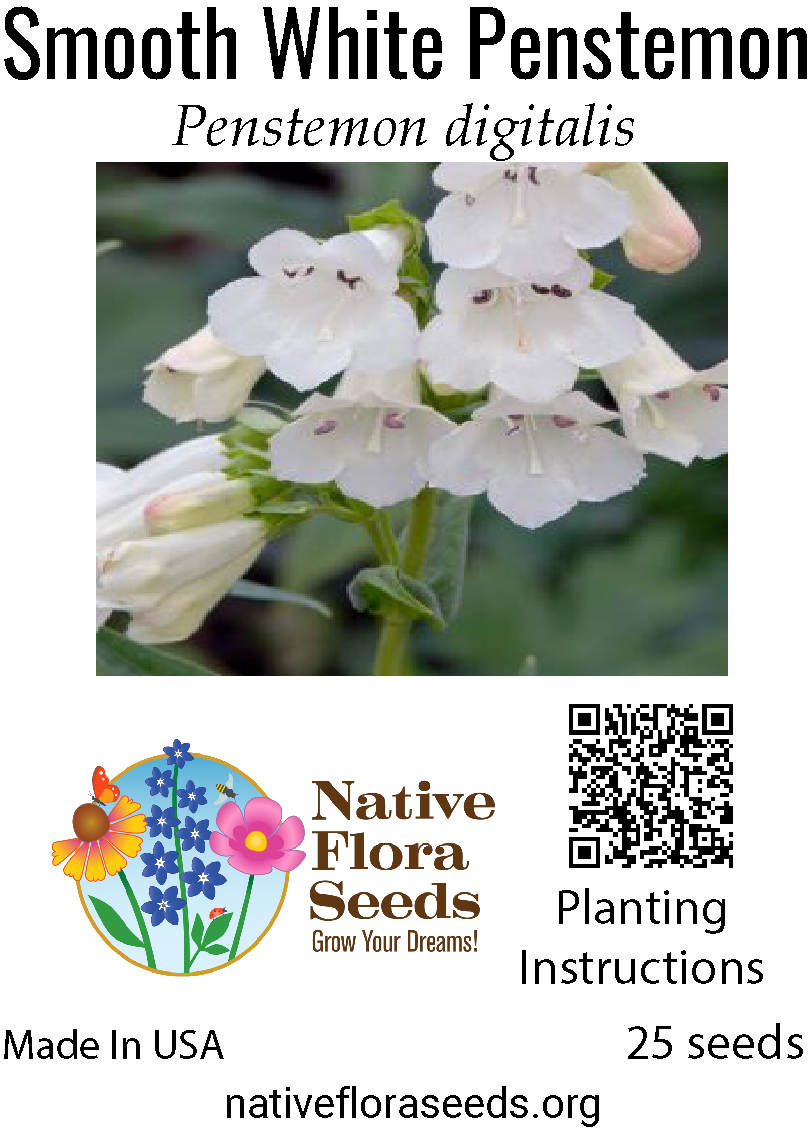Penstemon digitalis
Planting Instructions
Site Selection
Sunlight: Penstemon digitalis prefers full sun to partial shade. It needs at least 6 hours of sunlight for best flowering. In very hot climates, afternoon shade is beneficial.
Soil: Well-drained soil is crucial. Penstemon are susceptible to root rot in soggy soil. Sandy or loamy soils are ideal. Amend heavy clay soils with compost or other organic matter.
Space: These plants typically grow 2-3 feet tall and 1-2 feet wide, so space them accordingly.
Direct Sowing Outdoors
Fall Planting: Fall sowing is often preferred as it mimics the natural seed dispersal.
Preparation: Clear the area of weeds and debris. Lightly rake the soil surface to loosen it.
Planting Depth: Sow seeds very shallowly, barely covering them with a thin layer of soil or sand. Penstemon seeds need light to germinate.
Watering: Keep the soil consistently moist, but not soggy, until seedlings emerge.
Spring Planting: Spring planting is also possible, though germination may be less consistent.
Preparation: Prepare the seedbed as described above.
Planting Depth: Sow seeds as described above.
Watering: Water regularly until seedlings are established.
Starting Seeds Indoors
Timing: Start seeds indoors 8-10 weeks before the last expected frost in your area.
Stratification: Penstemon digitalis seeds benefit from cold stratification. This improves germination rates.
Mix seeds with slightly moistened sand or vermiculite.
Place the mixture in a sealed plastic bag.
Refrigerate for 4-6 weeks.
Planting:
Use a seed starting mix. Sow seeds very shallowly in seed starting trays or pots.
Keep the soil moist and provide warmth (70-75°F) for germination. Light is essential for germination.
Transplanting: Once seedlings have a few sets of true leaves and the weather has warmed (after the last frost), transplant them outdoors. Harden them off gradually by exposing them to outdoor conditions for increasing periods each day before transplanting.
Maintenance Tips
Watering: Once established, Penstemon digitalis is relatively drought-tolerant. Water deeply but infrequently, allowing the soil to dry slightly between waterings. Avoid overhead watering, as this can promote fungal diseases.
Fertilizing: Penstemon generally do not need heavy fertilization. A light application of a balanced fertilizer in spring is sufficient.
Deadheading: Remove spent flower spikes to encourage more blooms and prevent self-seeding if you don't want it to spread.
Mulching: A light layer of mulch can help retain moisture and suppress weeds.
Invasiveness
Penstemon digitalis is native to parts of eastern North America and is not generally considered invasive. However, it can self-seed in favorable conditions. If you want to prevent it from spreading, remove seed heads before they mature.
Additional Notes
Scarification: Scarification is not usually necessary for Penstemon digitalis seeds.
Pollinators: Penstemon digitalis is a great plant for attracting hummingbirds, bees, and butterflies to your garden.
Deer Resistance: Penstemon are relatively deer-resistant, though they may browse on them occasionally.
Important Considerations
Penstemon are susceptible to root rot, so well-drained soil is essential.
Provide good air circulation to help prevent fungal diseases.
With these tips, you should have success growing beautiful Penstemon digitalis in your garden!



